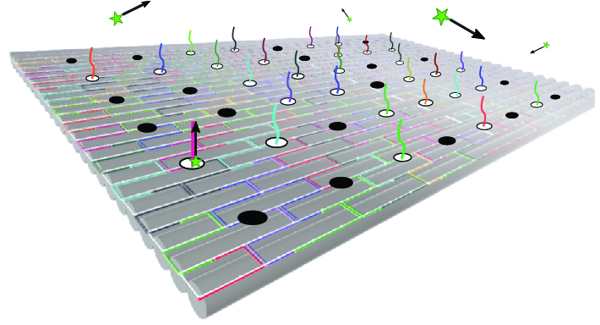Boise State University: Researchers Advance DNA as Memory Material
Potential alternative to silicon-based memory because volumetric density is 1,000x greater and energy of operation is 100 million times less than flash memory
This is a Press Release edited by StorageNewsletter.com on May 6, 2021 at 2:33 pmThe color of a person’s eyes, the thickness of a potato’s skin, and the shape of a flower: what do these seemingly disparate elements have in common? They are all shaped by DNA (Deoxyribonucleic acid) that encodes and carries the genetic instructions that shape life. But what if it could encode more than genetic information, such as digital archival data?
Will Hughes, professor, Micron School of Materials Science and Engineering
(John Kelly photo)
It might sound like something out of a science fiction movie, but in a novel study published in Nature Communications, members of Boise State’s Nucleic Acid Memory Institute revealed that the future of digital memory storage may be found in utilizing the programmable qualities of chemically synthesized DNA.
“We are simply taking advantage of the information density and programmability of DNA as a memory material,” explained Will Hughes. professor, Micron School of Materials Science and Engineering.
This innovation, dubbed Nucleic Acid Memory (NAM), harnesses the quaternary code of DNA (adenine, guanine, cytosine, thymine) to reliably store information well beyond the predicted lifetimes of traditional memory materials that make up HDDs, SSDs, and magnetic tape.
Led by Micron School of Materials Science and Engineering professor Hughes, and research scientist George Dickinson, the team was able to encode digital information into DNA, read it back using an optical microscope, and perform error correction on the data to ensure the integrity of the information. Additionally, this technique did not require sequencing technology, which historically has been necessary to read DNA information. The team’s research was published on April 22 in Nature Communications.
Support for this research came in 2018 from federal, state and industry agencies, including $2 million awarded by the Higher Education Research Council (HERC) Idaho Global Entrepreneurial Mission (IGEM), and $1.5 million jointly from the National Science Foundation and the Semiconductor Research Corporation.
Because the work lives at the intersection of materials science, computer science, bioengineering, and electrical engineering, a multidisciplinary team of faculty, staff, and students at Boise State pulled together to conduct this cutting-edge research. Hughes said that while the researchers each come from very different areas and fields of study, it is in fact the composition of these individuals and their skills that make this research possible.
The interdisciplinary research team included the expertise of faculty, post-doctoral research scientists and graduate students from across Boise State, including: Hughes, George Dickinson, William Clay, Luca Piantanida, Christopher Green, Chad Watson, Elton Graugnard, and Reza Zadegan, Micron School of Materials Science and Engineering; Golam Mortuza and Tim Andersen, Department of Computer Science; Eric Hayden, Department of Biological Sciences; and Wan Kuang, Department of Electrical and Computer Engineering.
“We always think of DNA as just something that can store genetic information, but we know so much about the molecular biology of DNA now that we can manipulate it, and instead of using it to store genetic information, you can use it as a building material,” said Dickinson.
This research could not come at a more pressing time. From entertainment streaming services to entire nations’ government archives, the globe’s ever-increasing digital information demands continue to rise. The data industry’s current standard for storage is flash memory, and it relies upon a natural resource: silicon. However, there is a problem.
Global data memory and storage demands are estimated to exceed the projected silicon supply by 2040. DNA is an important potential alternative to silicon-based memory because its volumetric density is 1000 x greater and its energy of operation is 100 million times less than flash memory. While the team does not anticipate DNA memory storage will completely replace flash/electronic memory, it will play an important role in widening the conversation as to possible new materials and methods.
“We may be running out of silicon 20 years from now if we don’t create new technology, and start looking for different ways to store information,” said Victor Zhirnov, chief scientist, Semiconductor Research Corporation in North Carolina. “Information and data storage is one of the major drivers of our economic and social well-being.”
Fortunately, as he points out, DNA storage methods such as those being tested in Boise State’s Nucleic Acid Memory Institute could be the answer to the world’s future information storage insecurity.
In the lab
In this research, the team began by using a long strand of DNA acquired from a bacteriophage (a kind of virus that parasitizes a bacterium) as a scaffold. The team then programmed the strand to fold itself into a ‘DNA breadboard’ using a process called DNA origami. The folding process was supported by the inclusion of short DNA strands called staple strands. Once folded, some of the staple strands extended from the DNA breadboard at particular spots that encoded digital information.
A breadboard is simply a surface that holds electronic components, such as chips and transistors, in a place where they can be built and tested together to develop prototypes. DNA can be used this way too and connected using their four quaternary bases.
An illustrative figure of staple strands of DNA self-assembled with scaffold DNA
to create an origami breadboard, provided by the research team
Next, the team encoded a message into these DNA breadboards: ‘Data is in our DNA!\n’. Using a super-resolution microscopy technique called DNA-Points Accumulation for Imaging in Nanoscale Topography (DNA-PAINT), the team was able to read back that message optically in binary code.
Additionally, the team used error-correction algorithms that were able to compensate for defects in the synthesis and reading process, making it possible to fully recover the encoded message.
This research builds upon earlier work conducted by Ralf Jungmann, a professor at Ludwig Maximilian University of Munich, and could make it possible to encode and store data in DNA, making it accessible tens or hundreds of thousands of years later, unlike modern memory storage.
As a steppingstone towards this goal, the team believes the research could prove to be valuable in applications that demand a small amount of data to be encoded into an exceedingly small package.
While archival storage is an aspirational goal for the field, “digital Nucleic Acid Memory is attractive for applications that demand a limited amount of data to have high information density, redundancy, and copy number such as encrypted barcodes,” said Hughes.
Article: An alternative approach to nucleic acid memory
Nature Communications has published an article written by George D. Dickinson, Micron School of Materials Science and Engineering, Boise State University, Boise, ID, USA, Golam Md Mortuza, Department of Computer Science, Boise State University, Boise, ID, USA, William Clay, Luca Piantanida, Christopher M. Green, Chad Watson, Micron School of Materials Science and Engineering, Boise State University, Boise, ID, USA, Eric J. Hayden, Department of Biological Sciences, Boise State University, Boise, ID, USA, Tim Andersen, Department of Computer Science, Boise State University, Boise, ID, USA, Wan Kuang, Department of Electrical and Computer Engineering, Boise State University, Boise, ID, USA, Elton Graugnard, Micron School of Materials Science and Engineering, Boise State University, Boise, ID, USA, Reza Zadegan, Department of Nanoengineering, Joint School of Nanoscience and Nanoengineering, North Carolina A&T State University, Greensboro, NC, USA, and Micron School of Materials Science and Engineering, Boise State University, Boise, ID, USA, and William L. Hughes, Micron School of Materials Science and Engineering, Boise State University, Boise, ID, USA.
Abstract: “DNA is a compelling alternative to non-volatile information storage technologies due to its information density, stability, and energy efficiency. Previous studies have used artificially synthesized DNA to store data and automated next-generation sequencing to read it back. Here, we report digital Nucleic Acid Memory (dNAM) for applications that require a limited amount of data to have high information density, redundancy, and copy number. In dNAM, data is encoded by selecting combinations of single-stranded DNA with (1) or without (0) docking-site domains. When self-assembled with scaffold DNA, staple strands form DNA origami breadboards. Information encoded into the breadboards is read by monitoring the binding of fluorescent imager probes using DNA-PAINT super-resolution microscopy. To enhance data retention, a multi-layer error correction scheme that combines fountain and bi-level parity codes is used. As a prototype, fifteen origami encoded with ‘Data is in our DNA!\n’ are analyzed. Each origami encodes unique data-droplet, index, orientation, and error-correction information. The error-correction algorithms fully recover the message when individual docking sites, or entire origami, are missing. Unlike other approaches to DNA-based data storage, reading dNAM does not require sequencing. As such, it offers an additional path to explore the advantages and disadvantages of DNA as an emerging memory material.“















 Subscribe to our free daily newsletter
Subscribe to our free daily newsletter

